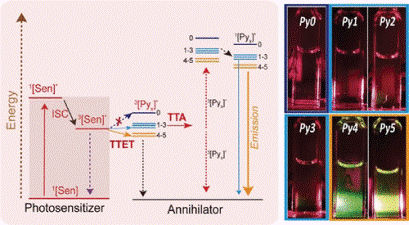Han Lab paper published in Journal of the American Chemical Society
Date Posted: Thursday, October 29, 2020
The Han Lab recently published a paper in the Journal of the American Chemical Society. Read the abstract below and take the link to the full text.
The paper is also featured in JACS twitter account: JACS Tweet
Highly Effective Near-Infrared Activating Triplet-Triplet Annihilation Upconversion for Photoredox Catalysis
Abstract Organic triplet–triplet annihilation upconversion (TTA-UC) materials have considerable promise in areas as broad as biology, solar energy harvesting, and photocatalysis. However, the development of highly efficient near-infrared (NIR) light activatable TTA-UC systems remains extremely challenging. In this work, we report on a method of systematically tailoring an annihilator to attain such outstanding systems. By chemical modifications of a commonly used perylene annihilator, we constructed a family of perylene derivatives that have simultaneously tailored triplet excited state energy (T1) and singlet excited state energy (S1), two key annihilator factors to determine TTA-UC performance. Via this method, we were able to tune the TTA-UC system from an endothermic type to an exothermic one, thus significantly elevating the upconversion performance of NIR light activatable TTA upconversion systems. In conjunction with the photosensitizer PdTNP (10 μM), the upconversion efficiency using the optimal annihilator (100 μM) identified in this study was measured to be 14.1% under the low-power density of NIR light (100 mW/cm2, 720 nm). Furthermore, using such a low concentration of perylene derivative, we demonstrated that the optimal TTA-UC pair developed in our study can act as a highly effective light wavelength up-shifter to enable NIR light to drive a photoredox catalysis that otherwise requires visible light. We found that such an NIR driven method is highly effective and can even surpass directly visible light driven photoredox catalysis. This method is important for photoredox catalysis as NIR light can penetrate much deeper in colored photoredox catalysis reaction solutions, especially when done in a large-scale manner. Furthermore, this TTA-UC mediated photoredox catalysis reaction is found to be outdoor sunlight operable. Thus, our study provides a solution to enhance NIR activatable organic upconversion and set the stage for a wide array of applications that have previously been limited by the suboptimal efficiency of the existing TTA upconversion materials.
Organic triplet–triplet annihilation upconversion (TTA-UC) materials have considerable promise in areas as broad as biology, solar energy harvesting, and photocatalysis. However, the development of highly efficient near-infrared (NIR) light activatable TTA-UC systems remains extremely challenging. In this work, we report on a method of systematically tailoring an annihilator to attain such outstanding systems. By chemical modifications of a commonly used perylene annihilator, we constructed a family of perylene derivatives that have simultaneously tailored triplet excited state energy (T1) and singlet excited state energy (S1), two key annihilator factors to determine TTA-UC performance. Via this method, we were able to tune the TTA-UC system from an endothermic type to an exothermic one, thus significantly elevating the upconversion performance of NIR light activatable TTA upconversion systems. In conjunction with the photosensitizer PdTNP (10 μM), the upconversion efficiency using the optimal annihilator (100 μM) identified in this study was measured to be 14.1% under the low-power density of NIR light (100 mW/cm2, 720 nm). Furthermore, using such a low concentration of perylene derivative, we demonstrated that the optimal TTA-UC pair developed in our study can act as a highly effective light wavelength up-shifter to enable NIR light to drive a photoredox catalysis that otherwise requires visible light. We found that such an NIR driven method is highly effective and can even surpass directly visible light driven photoredox catalysis. This method is important for photoredox catalysis as NIR light can penetrate much deeper in colored photoredox catalysis reaction solutions, especially when done in a large-scale manner. Furthermore, this TTA-UC mediated photoredox catalysis reaction is found to be outdoor sunlight operable. Thus, our study provides a solution to enhance NIR activatable organic upconversion and set the stage for a wide array of applications that have previously been limited by the suboptimal efficiency of the existing TTA upconversion materials.

